Meg Mackintosh Solves Seven American History Mysteries (4 page)
Read Meg Mackintosh Solves Seven American History Mysteries Online
Authors: Lucinda Landon

“Are those flint?” asked Peter.
“Yes, they're firestarters. They're important because fire is vital for survival.” Then he pointed to the symbol on the rock, smiled, and said, “The star symbol means Anockus.”
“Anockus! That's the mystery child!” exclaimed Meg.
“And the star is the symbol on the rock and symbol in the clue, too. So the âR' stands for someone else,” Peter reasoned.
“A pilgrim child?” Meg wondered as she stared at the list of names Gramps had given her. “Who do you think it was?”
Can you imagine what the story behind the mystery might be?
Meg and Peter thought hard about the pieces of the mystery and began to realize how the clues, the symbols, and the names might fit together. They speculated about what may have happened on a winter night in the 1620s, and then ran to tell Gramps their historical hunch, or hypothesis.
“Anockus must have been a Wampanoag boy who lived near the Pilgrims in Plimoth,” Peter concluded.
“He put the symbol of his name on one of his firestarters,” added Meg. “I bet there was a really bad winter storm and many of the Pilgrims were suffering. Maybe Anockus noticed that a fire was out in one of the chimneys, or maybe an English boy or girl came to him for help because they couldn't get the fire started.”
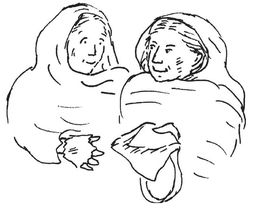
“They could have lost their flint or perhaps it was damaged. Or maybe their parents were too ill to help them,” Peter conjectured.
“So Anockus must have given them his stones to start a fire and his leather friendship bag to keep them in. He probably saved their lives. But who do you think the âR' stood for?” Peter wondered.
“Maybe the âR' stood for Remember Allerton. We'll never know for sure,” said Meg.
“But the leather pouch was never returned to Anockus,” said Peter.
“Somehow, Professor Brown acquired it and figured out what the symbols stood for. He wanted it returned to its original owners â Anockus's people â the Wampanoag.”
Meg and Peter took the leather pouch to the curator of Native American artifacts at the museum. She was thrilled to have it for their collection.
Meg and Peter congratulated themselves on solving the case, but they couldn't help imagining what it must have been like to live in Plimoth in the 1620s as a Wampanoag or as an immigrant to the new land.
“I'll never forget the name Anockus,” said Meg wistfully.
“Nutmeg, I'll never remember the name âRemember',” Peter replied.
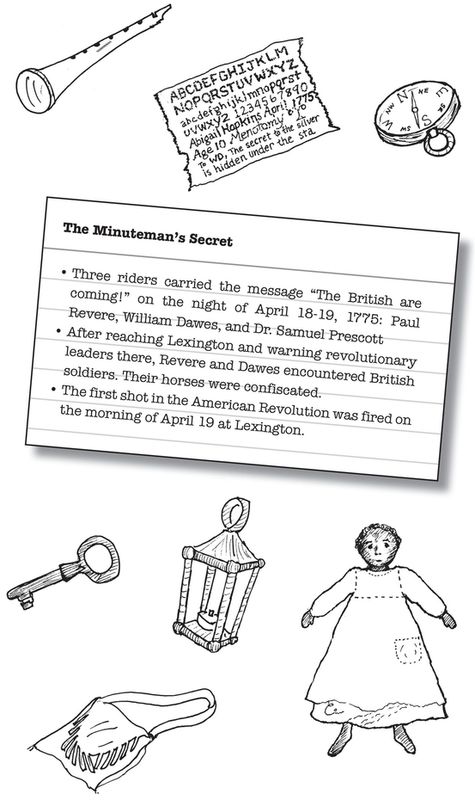
The Minuteman's Secret
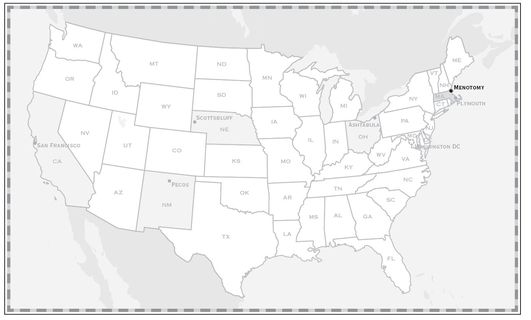
“Menotomy, Massachusetts, is the next stop on our history mystery tour,” said Peter as he held up the slip of paper. He unfolded a map of the United States. “Here's Menotomy, near Boston.”
“I've seen the name Menotomy on a few sites near Boston,” Gramps told them. “Let's go to a local library and find out where it is, or was. Many old villages are swallowed by bigger towns and lost in history.”
Meanwhile, Meg was carefully lifting all the artifacts from the old chest and studying them for clues. Suddenly she noticed something connected the location with an artifact.
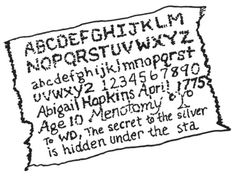
What did Meg notice? Which artifact belongs with this mystery?
“What about this old sampler?” Meg suggested.
“What exactly is a sampler?” Peter asked, as he watched for road signs out the window.
“Young girls made them to practice their sewing skills.” Meg studied the old cloth. “It's signed Abigail Hopkins. That's one of the names Professor Brown gave us. She was ten years old and she lived in Menotomy!”
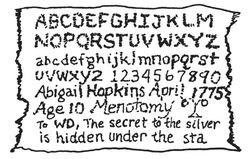
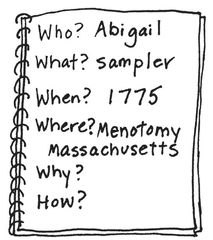
“And check out the date!” Meg exclaimed. “Abigail made it in 1775.” Meg couldn't take her eyes off the intricately embroidered alphabet. She ran her fingers along the letters. The colors of the silk thread were faded; the linen brittle with age.
“Meg, look at the last line she sewed: âTo W.D. The secret to the silver is hidden under the sta.' It definitely sounds like the clue to the history mystery. Isn't it weird that she didn't finish? What do you think happened to her?”
“We should read the clues before we start jumping to conclusions,” suggested Meg.
“Good idea,” said Gramps as he handed the envelope to them. Meg opened the envelope. “This is an odd looking clue,” she said.

How could you read this message?
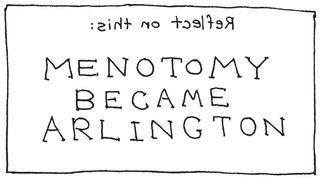
“I've got an idea,” said Meg, climbing into the front seat.
She pulled the passenger visor down and held the message in front of the mirror. “Reflect the message in the mirror!”
“Hey! I know Arlington! That's where Willy's cousin lives!” Peter said. “It's by Cambridge, just outside of Boston.”
“Then we should go to the Arlington Public Library,” said Meg as she carefully packed the sampler into her detective knapsack.
When they arrived in Arlington, Gramps went to get lunch, and Meg and Peter headed to the library. “The town of Arlington used to be called Menotomy, the Native American name,” explained the librarian as she pored over the old record books. “And yes, there was a girl named Abigail Hopkins who lived here. She was the daughter of Ezekial and Anna Hopkins. She's buried in the old town cemetery up the hill. Her gravestone is probably very worn, but you might be able to find it.”
“This is creepy,” said Peter, “but I like it.”
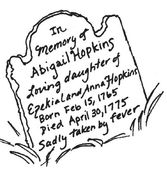
“We'd better hurry,” Meg advised. “Gramps told us to meet him at the minivan at one o'clock. That doesn't give us much time.”
After an hour's search, Meg called out, “Peter, I found it! It's so sad; Abigail died of a fever April 30, 1775.”
“So that's why she never finished the sampler,” said Peter.
Meg took the sampler out of her knapsack. “Look at the last line â I guess Abigail was in the middle of telling someone about the silver when she became ill.”
“Yeah, or maybe that last line is just a silly old nursery rhyme,” Peter said, taking the sampler from Meg. He stared at the date. “April 1775 â I know that date is important⦔
What happened in April 1775?
“I've got it!” exclaimed Peter. “It's from the poem I memorized for class.
Paul Revere's Ride
by Henry Wadsworth Longfellow.” He recited the beginning, quite dramatically:
Listen, my, children, and you shall hear
Of the midnight ride of Paul Revere
On the eighteenth of April, in Seventy-five;
Hardly a man is now alive
Who remembers that famous day and year.
“Peter, you're right,” said Meg. “Paul Revere rode north from Boston through this area to warn the colonists at the beginning of the Revolutionary War. He was one of the minutemen! I wonder what his secret was?”
“Quick, let's check with the librarian again and see if he passed through this town. Maybe that's the night Abigail wrote the message,” Meg said, dashing with her brother back to the library.
What would you do next?
“Yes, indeed, this town was on Paul Revere's route to Lexington and Concord,” the librarian explained. She smiled at the young historians before her as she pulled out a map. “William Dawes, the other rider, also rode through Menotomy.”
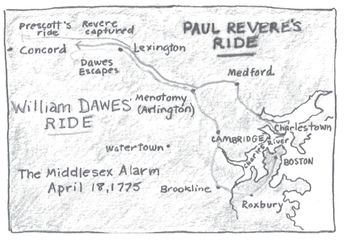
“William Dawes!” Meg exclaimed. She almost fell off the edge of her seat.
Why did Meg jump at the mention of William Dawes?
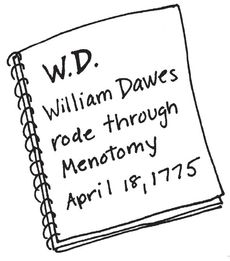
“The message on the sampler was inscribed to W. D. It's
got
to be William Dawes! Maybe he stopped at Abigail's house to get a drink of water for his horse or something,” she said excitedly. “Imagine being awakened by the call, âThe British are coming!'”
